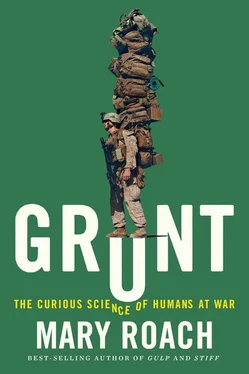“What the fuck is wrong with you, Baker?!”
Nothing, in fact. Just his sympathetic nervous system doing its job. Anything perceived as a threat trips the amygdala—the brain’s hand-wringing sentry—to set in motion the biochemical cascade known as the fight-or-flight response. Bruce Siddle, who consults in this area and sits on the board of Strategic Operations, prefers the term “survival stress response.” Whatever you wish to call it, here is a nice, concise summary, courtesy of Siddle: “You become fast, strong, and dumb.” Our hardwired survival strategy evolved back when threats took the form of man-eating mammals, when hurling a rock superhumanly hard or climbing a tree superhumanly fast gave you the edge that might keep you alive. A burst of adrenaline prompts a cortisol dump to the bloodstream. The cortisol sends the lungs into overdrive to bring in more oxygen, and the heart rate doubles or triples to deliver it more swiftly. Meanwhile the liver spews glucose, more fuel for the feats at hand. To get the goods where the body assumes they’re needed, blood vessels in the large muscles of the arms and legs dilate, while vessels serving lower-priority organs (the gut, for example, and the skin) constrict. The prefrontal cortex, a major blood guzzler, also gets rationed. Good-bye, reasoning and analysis. See you later, fine motor skills. None of that mattered much to early man. You don’t need to weigh your options in the face of a snarling predator, and you don’t have time. With the growing sophistication and miniaturization of medical equipment, however, it matters very much to a corpsman. Making things worse, the adrenaline that primes the muscles also enhances their nerve activity. It makes you tremble and shake. Add to this the motions and vibrations of a medevac flight, and you start to gain an appreciation for the military medic’s challenges.
On top of caring for the wounded, corpsmen are expected to return fire if no one else is able. Like any precision task, marksmanship deteriorates in high-stress situations. The average police officer taking a qualifying test on a shooting range scores 85 to 92 percent, Siddle told me, but in actual firefights hits the target only 18 percent of the time.
The corpsman trainee working on Caezar is having difficulty with the tourniquet. Like Baker, he’s a fine, fumbling example of the downside of an adrenaline rush. An instructor puts his head through the doorway. “What are we doing in here, fuckin’ organ transplant? Let’s go!”
If the scenario were real, Caezar would be dead by now. With a large artery bleed, it can take less than two minutes for the human heart—and, no coincidence, the Strategic Operations Blood Pumping System—to hemorrhage three liters: a fatal loss. The human body holds five liters of blood, but with three gone, electrolyte balance falls gravely out of whack, and there’s not enough circulating oxygen to keep vital organs up and running. Hemorrhagic shock—“bleeding out”—is the most common cause of death in combat.
This is the grim calculus of emergency trauma care. The more devastating the wounds, the less time there is to stabilize the patient. The less time there is and the graver the consequences, the more pressure medics are under—and the more likely they are to make mistakes. In a 2009 review of twenty-two studies on the effects of “stressful crises” in the operating room, surgeons’ performance was reliably compromised: not only their technical skills but their ability to make good decisions and communicate effectively. And the stressful crises of the operating room—defined in this study as bleeding, equipment malfunctions, distractions, and time pressure—are business as usual in a theater of war.
Caezar exits the scene in a fireman carry, draped around a trainee’s neck like a heavy mink stole. Baker follows behind with the stretcher. He’s struggling because his palms are sweaty. He sets down his end in order to wipe his hands on his pants—again, without alerting the guy holding the other end.
“ Really, Baker?” Palm sweat is a feature of fight-or-flight thought to have evolved to improve one’s grip, but too much of it obviously has the opposite effect. “Put your fuckin’ little girl gloves on if you have to.”
The instructors are mean for a reason. They aim to subject the trainees to as much fear and stress as they can without actually shooting at them. The entire experience—the mock injuries, the gunfire and explosion sounds, the anguish of being called a little girl in front of everyone—is meant to function as a sort of emotional vaccine. Combat training for all troops, not just medics, has traditionally included exposure to some kind of simulated gore and mayhem. For years, writes Colonel Ricardo Love in his 2011 paper “Psychological Resilience: Preparing Our Soldiers for War,” commanders have shown their charges photos and videos of gruesome injuries, or brought in veterans to talk about “the horrors they experienced.” To help prepare future corpsmen, the Naval Health Research Center hands out copies of The Docs , a 200-page comic book with lurid drawings of blast and gunshot injuries—a graphic graphic novel.
The pyrotechnics and battle soundtrack not only add realism but also kick-start the fight-or-flight reaction. Sudden loud noise triggers a cluster of split-second protective reflexes known as the startle pattern. You blink to protect your eyes, while your upper body swivels toward the sound to assess the threat. The arms bend and retract to the chest, the shoulders hunch, and the knees bend, all of which combine to make you a smaller, less noticeable target. Snapping the limbs in tight to the torso may also serve to protect your vital innards. [22] But not your iPhone. Smart smartphone thieves use the startle reaction to their advantage. They come up behind unsuspecting texters and whap them on the back of the head. The startled victim’s arms bend, launching the phone, which is effectively tossed to the thief.
You are your own human shield. Siddle says hunching may have evolved to protect the neck: a holdover from caveman days. “A big cat stalking prey will jump the last twenty feet and come down on the back and shoulders and bite through the neck.”
This may lead you to wonder, do impalas and zebras exhibit the startle pattern? And you would not be first in wondering. In 1938, psychologist Carney Landis spent some time at the Bronx Zoological Park, testing the evolutionary reach of the startle pattern, and the patience of zoo staff. In exhibit after exhibit, Landis could be seen setting up his movie camera and firing a .32-caliber revolver into the air. Less unsettling for zoo visitors—and more entertaining—would have been the experimental technique of fellow startle response researcher Joshua Rosett, who snuck up behind his (human) subjects and flicked the outer edge of their ear with his index finger. I imagine it was a trying time for the Rosett family.
The Bronx Zoo had no impalas, but they did have a goatlike Himalayan tahr, and it was duly startled. As was the two-toed sloth, the honey badger, the kinkajou, the dingo, the Tibetan bear, the jackal, and every other mammal that endured the scientific obnoxiousness of Carney Landis.
You will not be startled to learn that Landis’s book-length treatment of the topic, The Startle Pattern, fell somewhat shy of runaway success.
TODAY’S SECOND scenario is a simulation of the aftermath of an explosion on a Navy destroyer. I have a symptom this time: smoke inhalation burns, which entitles me to some lines and a perioral dusting of soot. The set comprises a room of sailors’ bunks, or “racks,” and a sick bay down the hall. Catwalks overhead allow instructors to observe the trainees and hurl down invective.
Читать дальше












